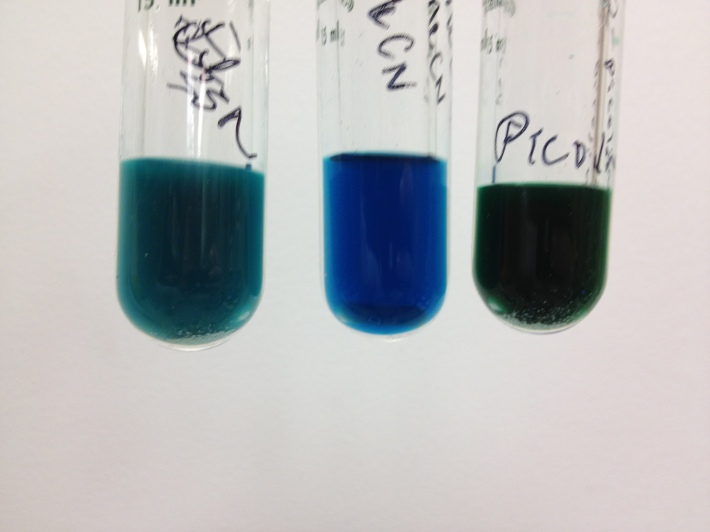Dear Glovebox,
I’ve only had you for a few months now, but I think it’s time I go public with the way I’m feeling. I love working with you.
Now, I know some people say that you’re “over-the-top,” but that’s what I love about you. Sure, not everyone has a glovebox, so I will eventually have to demonstrate reactions on the Schlenck line. That said, setting up a screen with air sensitive reagents and NOT having to deal with N2 balloons, umbrellas, or other methods of keeping things safe is the greatest thing. I can’t remember what it’s like to use BuLi as a solution anymore; weighing it out as a solid is the single easiest thing I can think of!
So, this is my way of thanking you, glovebox, for making my life that much easier and for allowing me to discover chemistry I wouldn’t otherwise be able to observe without a pristine atmosphere. You let me revel in my OCD concerning reagent purity, and that’s never a bad thing!
For those who don’t understand my love, see this macrocrystalline sample of LiHMDS:
Pretty, right? I’m not sure I could ever have conceived of isolating this outside of the glovebox!
Yours truly,
Organometallica
Below the cut, some more pictures of pretty things from the box that I have lying about. Most often, I take pictures because my advisor is constantly asking what color my products are. :face palm:
Cobalt carbene complexes, each with a different neutral donor ligand. Aside from that donor ligand, each is structurally identical!
 A cobalt(II) complex (technically outside the box, prepared under inert atmosphere then heated on a stir plate in my hood)
A cobalt(II) complex (technically outside the box, prepared under inert atmosphere then heated on a stir plate in my hood)
I’ll add more as I find them!




This is my favorite post you’ve ever written.
Yay crystals! And yay gloveboxes!
I am a French major with little more than a working understanding of high school chemistry, but I am mesmerized by your blog. Probably because you make pretty crystals in refrigerator robots with wiggly hands, and explain why I get my toothpaste confiscated when I fly home from college.
Hey Kate, thanks for your message! I am actually a chemist with a working understanding of high school French, so with our powers combined, we form French Scientist Captain Planet! Knowing some French actually helped me translate a French paper for a student of mine. I was amazed that I was able to stumble through the experimental!
Anyway, I am really glad you read the blog, as “Non-specialists” like yourself are the people I really hope to reach. However, I will dedicate a post to describing how the wiggly-handed refrigeratorbot works! 😉
did you physically put the camera inside the glovebox? Since long time I’m thinking of doing it, but I don’t know if the camera will survive the purge cycles. They are resistant to high pressure but no one knows about vacuum… btw, nice post
I didn’t, these are through the plastic with my iPhone. I find that some electronics can survive but most don’t. For instance we put fans in our box but they were put in during the initial setup; experience has shown that when the fans eventually die, the only way to get another one in is to bring it in without vac right before a regen. Not worth the huge O2 spike that obv. Comes with it.
too bad, I really want to film from the inside the glove box. I’ll find a way sooner or later :-\
The key detail I didn’t mention was that you’re exactly right; electronics tend to be fine at elevated pressure but die under vacuum.
yep, because you can go under the sea, but it’s quite hard that you go to the space 🙂
I don’t know about a real camera, or about bringing it down to the vacuum that glovebox antechambers get to, but you can bring a phone down to pretty low pressures and still have it work. One of my coworkers at my old co-op got her phone wet, so she stuck it in one of the lyophilizers for a day and it worked fine afterwords.
Yeah, it totally depends. Sometimes it’ll be fine, sometimes it dies, generally skewing toward the latter in my experience, using desk fans and small gadgets as my reference. Most importantly, I’m not so compelled to take pictures within the box that I need to risk ruining a camera. 😛
What we have thought about doing is using one of the back ports to install a fiber optic microscope that connects to a display outside the box. Stay tuned.
Great post, love the crystals. One of my friends had to crystallise a oxidation-sensitive protein in a glovebox/oxygen-deficient environment. It sounded very difficult, especially considering the leg-work behind setting up and inspecting crystal screens….!
i almost cry and just because i dont have a GB! what a nice pics you have and you’re totally right, there’s a world of difference between trying organomet chem with and without a GB, maybe one day on my dreams 😮
Cool! So, it’s not weird that I really, really, really like the barrier Isolators at work? They fill vials & syringes in a sterile environment. I like the machines because they’re precise, but I also like the barrier Isolators around the machinery because they protect me & coworkers from pharmaceuticals as well as keeping the medicines sterile. Ingenious design! Wonderful invention, Isolators!